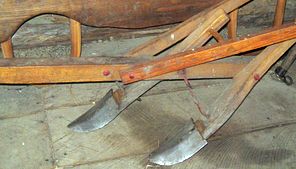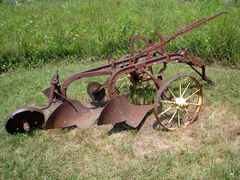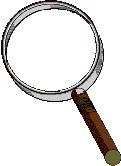A device consisting of pointed stick or blade drawn through the surface of a field to cut through and open the soil in preparation for planting a new crop.
Contrast: dibble.
Comment:Although agriculture in the sense of the deliberate planting of crops emerged about 8000 BC, some specialists prefer to define agriculture (as opposed to horticulture or "gardening") as necessarily involving the use of a plow to break up the surface of the soil.

Earliest "scratch plows" pulled by human and/or animal power are known from about 6000 BC. The earliest plows were little more than pointed sticks held down by a farmer while being pulled forward by a horse or ox. By about 3500 BC, plowshares had been developed, which had a kind of flat, wedge shape, turning over a broader furrow. (The picture at left shows a double one for cutting two furrows at once.).
By perhaps AD 1100 the so-called "moldboard plow" was developed, with a slightly curved blade that not only cut into the soil, but flipped over the sod it loosened, burying the surface weeds to rot beneath the ground (right picture). The development of the steel moldboard is credited with breaking through the prairie lands of central North America to make them suitable for crops.

Because plowing loosens the surface soil, it raises risks of wind and water erosion. To some extent, water erosion can be controlled by "contour plowing" on hilly terrain, so that furrows run perpendicular to the angle of the hillside. However, this provides only partial protection, and in the late XXth century a "no-till" movement arose seeking ways to make non-plow agriculture as efficient as plow agriculture, partly through the controversial use of more herbicides to kill weeds formerly plowed under to produce fertilizer.
See agriculture.
